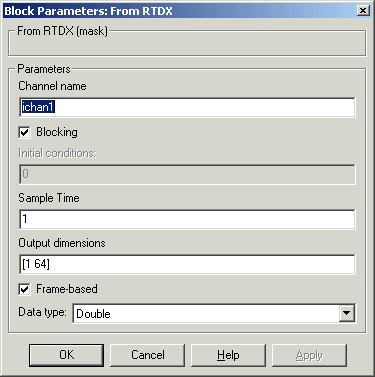| Embedded Target for Texas Instruments C6000 DSPs |
  |
From Rtdx
Add a named RTDX input channel to Simulink models
Library
rtdxBlocks in Embedded Target for TI C6000 DSP for TI DSP
Description

When you generate code from your Simulink model in Real-Time Workshop with this block in place, code generation inserts the C commands to create an RTDX input channel on the target. The inserted code opens and enables the channel with the name you specify in Channel name in the block parameters. You can open, close, disable, and enable the channel from the host side afterwords, overriding the target side status.
In the generated code, you see a command like the following
where channelname is the name you enter in Channel name.
In simulations this block does not perform any operations with the exception that the block will generate an output matching your specified initial conditions. From Rtdx blocks work only in code generation and when your model runs on your target.
The initial conditions you set in the block parameters determine the output from the block to the target for the first read attempt. Specify the initial conditions in one of the following ways:
- Scalar value--the block generates one output sample with the value of the scalar. For a value of 0, the block outputs a zero to the processor. When Output dimension specifies an array, every element in the array has the same scalar value.
- Null array ([ ])--same output as a scalar with the value zero for every sample.
Using RTDX in your model involves:
- Adding one or more To Rtdx or From Rtdx blocks to your model to prepare your target
- Downloading and running your model on your target
- Enabling the RTDX channels from MATLAB
- Using the
readmsg and writemsg functions in MATLAB to send and retrieve data from the target over RTDX
To see more details about using RTDX in your model, refer to
Tutorial 3-2--Using Links for RTDX.
Dialog Box

- Channel name
- Defines the name of the input channel to be created by the generated code. Recall that input channels refer to transferring data from the host to the target (input to the target). To use this RTDX channel, you enable and open the channel with the name, and send data from the host to the target across this channel. Specify any name as long as it meets C syntax requirements for length and character content.
- Blocking
- Puts RTDX communications into blocking mode where the target processor waits to continue processing until new data is available from the From Rtdx block. Selecting blocking mode slows your processing while the processor waits--if your new data is not available when the processor needs it, your process stops. In nonblocking mode, the processor uses old data from the block when new data is not available. Nonblocking operation is the default and recommended for most operations.
- Selecting the Blocking option disables the Initial conditions option.
- Initial conditions
- Specifies what data the processor reads from RTDX for the first read. This can be 0, null ([ ]), or a scalar. You must have an entry for this option. Leaving the option blank causes an error in Real-Time Workshop.
- Sample time
- Specifies the time between samples of the signal. The default is 1 second between samples, for a sample rate of one sample per second (1/Sample time).
- Output dimensions
- Defines a matrix for the output signal from the block, where the first value is the number of rows and the second is the number of columns in the output matrix. For example, the default setting [1 64] represents a 1-by-64 matrix of output values. Enter a 1-by-2 vector of doubles for the dimensions.
- Frame-based
- Sets a flag at the block output that directs downstream blocks to use frame-based processing on the data from this block. In frame-based processing, the samples in a frame are processed simultaneously. In sample-based processing, samples are processed one at a time. Frame-based processing can greatly increase the speed of your application running on your target. Note that throughput remains the same in samples per second processed. Frame-based operation is the default.
- Data type
- Sets the type for the data coming from the block. Select one of the following types:
- Double--double-precision floating point values. This is the default setting. Values range from -1 to 1.
- Single--single-precision floating point values ranging from -1 to 1.
- Uint8--8-bit unsigned integers. Output values range from 0 to 255.
- Int16--16-bit signed integers. With the sign, the values range from -32768 to 32767.
- Int32--32-bit signed integers. Values range from -231 to (231-1).
See Also
ccsdsp, readmsg, To RTDX, writemsg
 | FFT | | General Real FIR |  |




![]()

